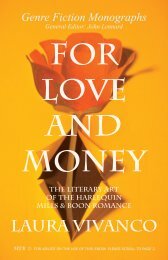Genre Fiction Monographs - Humanities-Ebooks
Genre Fiction Monographs - Humanities-Ebooks
Genre Fiction Monographs - Humanities-Ebooks
Create successful ePaper yourself
Turn your PDF publications into a flip-book with our unique Google optimized e-Paper software.
<strong>Humanities</strong>-<strong>Ebooks</strong><br />
<strong>Genre</strong> <strong>Fiction</strong> <strong>Monographs</strong><br />
Of Sex and Faerie<br />
further<br />
essays<br />
on<br />
<strong>Genre</strong><br />
<strong>Fiction</strong><br />
John Lennard
Is this sample what you are looking for?<br />
If so, please browse our lists<br />
or look for different formats at:<br />
http://www.humanities-ebooks.co.uk<br />
or buy this PDF book<br />
HERE<br />
About <strong>Humanities</strong> <strong>Ebooks</strong><br />
<strong>Humanities</strong>-<strong>Ebooks</strong> is an an authors’ co-operative, not a commercial publisher.<br />
Our aim is to produce inexpensive, high quality <strong>Ebooks</strong>, and to pass the maximum<br />
possible proportion of the purchase price to their authors.<br />
Almost all our titles are available in Kindle format, though for academic books<br />
and those with complex layout the PDF is almost invariably superior.<br />
All our titles can be ordered by libaries through Ebrary, EBSCO and MyiLibrary.<br />
Paperback versions of many of our titles can be reached via the book descriptions<br />
on our website.
Of Sex and Faerie<br />
Further essays on <strong>Genre</strong> <strong>Fiction</strong><br />
John Lennard<br />
HEB ☼ <strong>Humanities</strong>-<strong>Ebooks</strong>
Copyright<br />
Text © 2010 John Lennard<br />
The Author has asserted his right to be identified as the author of this Work in accordance<br />
with the Copyright, Designs and Patents Act 1988.<br />
First published by <strong>Humanities</strong>-<strong>Ebooks</strong> LLP,<br />
Tirril Hall, Tirril, Penrith CA10 2JE.<br />
The PDF ebook (with the facility of word and phrase search) is available from http://www.<br />
humanities-ebooks.co.uk and MyiLibrary.com.<br />
A Kindle ebook in reflowable format is available from Amazon.com but the PDF version is<br />
recommended for larger devices such as the Kindle DX, Dell Streak, and Apple iPad.<br />
The paperback is available at a discount from http://www.troubadour.co.uk and at the rrp<br />
from all booksellers.<br />
The author and publisher have used their best efforts to ensure that external URLs given<br />
in this book are accurate and current. They are not, however, responsible for any of these<br />
websites, and can offer no guarantee that the sites remain live or the content appropriate.<br />
ISBN 978-1-84760-171-1 pdf (fixed page format)<br />
ISBN 978-1-84760-172-8 ePub (Reflowable format)<br />
ISBN 978-1-84760-173-5 paperback
Contents<br />
List of Illustrations 7<br />
Acknowledgements 8<br />
Foreword 9<br />
1. Of Policemen and Poussin 10<br />
Bill James’s Dance to the Muzak of Crime<br />
2. Of Mean Streets and Mortgaged Castles 47<br />
Walter Mosley, Easy Rawlins, and the G. I. Bill<br />
3. Of Marriage and Mutations 70<br />
Lois McMaster Bujold and the Several Lives of Lord Miles<br />
Naismith Vorkosigan<br />
4. Of Sex and Faerie 112<br />
Meredith Gentry’s Improbable Code of Orgasm and other<br />
Paranormal Romance<br />
5. Of Voyages and Volumes 165<br />
The Many Successors of C. S. Forester and Horatio Hornblower<br />
6. Of the Western Shore 223<br />
Ursula K. Le Guin’s Late Distillation of Fable<br />
7. Of Criticism and Continuities 246<br />
A Personal Account of Serial Reading in the Age of the Web<br />
Bibliography 309<br />
A Note on the Author 441
Further Essays in <strong>Genre</strong> <strong>Fiction</strong> <br />
List of Illustrations<br />
Cover. Sophie Gengembre Anderson (1823–1903), Take the Fair Face of Woman,<br />
and Gently Suspending, with Butterlies, Jewels, and Flowers Attending, Thus Your<br />
Fairy is Made of Most Beautiful Things (private collection).<br />
1. Nicolas Poussin, The Dance to the Music of Time (c.1634–6)<br />
2. The film-poster for Devil in a Blue Dress (1995) …<br />
3. Johann Heinrich Füssli, Die Elfenkönigin Titania (1793–4, detail)<br />
4. Johann Heinrich Füssli, Prinz Arthur und die Feenkönigin (c.1788)<br />
5. Graphs of the human sexual response cycle …<br />
6. Three of the ‘Aids That Every Woman Appreciates’ …<br />
7. J. M. W. Turner, The Battle of Trafalgar (1822)<br />
8. Alfred Kroeber and ‘Ishi’, 1912.
Further Essays in <strong>Genre</strong> <strong>Fiction</strong> <br />
Foreword<br />
As its subtitle implies, this volume extends an earlier collection, Of Modern Dragons<br />
and other essays on <strong>Genre</strong> <strong>Fiction</strong> (2007), in which I sought to bring professional critical<br />
attention to bear on both particular genre authors and tropes, and the phenomenon<br />
of ‘serial reading’—engagement, over successive years and volumes, with a series cast,<br />
locale, and protagonist/s. That phenomenon is also central to this collection, for all the<br />
essays are concerned with individual or grouped series, with most of which I have lived<br />
for years, even decades, and the last with the praxis of serial reading (and writing) in<br />
the age of the Web.<br />
What (if anything) authors considered here have in common besides serial composition<br />
of genre fictions and my extended attention is moot, but I have found myself<br />
repeatedly concerned with relations between series, and between sub-genres, crossconnections<br />
that insist on a far greater intergeneric fertility that either marketing or<br />
criticism commonly allow genre work. Contemporary and recent history is also a concern<br />
uniting crime, science fiction, and romance, sometimes blossoming (as in David<br />
Weber’s Honor Harrington series) into full-blown engagement with military history, or<br />
(as in Laurell K. Hamilton’s Meredith Gentry series) with our post-Darwinist sexual<br />
self-understanding in a time of AIDS and Rohypnol. The passage and manipulation of<br />
time in and between series novels also recurs across the genres. And all the essays are<br />
arguments, implicit and explicit, for the qualities and relevance of recent genre writing<br />
and its relations with older literature.<br />
Given all the series discussed my bibliography is very lengthy—a deliberate fullness,<br />
for many genre authors do not have available bibliographies of academic standard<br />
(though the e-retailer fantasticfiction.com has done wonders). To provide complete<br />
entries for all authors would have been extremely arduous—but readers who wish to<br />
pursue any of the genre writers I mention, for pleasure or study, will find more than adequate<br />
means of doing so. Additionally, my insistent provision, in main text and footnote<br />
of authorial and publication dates, even at the cost of cluttering sentences, and in the<br />
bibliography of data about awards, represents a deliberate historicisation in detail—a<br />
grounding as essential to worthwhile genre studies as to all other literary criticism.<br />
John Lennard<br />
Cambridge, UK, 1 April 2010
1. Of Policemen and Poussin<br />
Bill James’s Dance to the Muzak of Crime<br />
Allan James Tucker (b. 1929) has for five decades been a remarkably prolific,<br />
entertaining, and interesting writer. Besides two works of non-fiction and five<br />
novels published since 1960 in propria persona as James Tucker, there is a large body<br />
of pseudonymous work—19 novels by ‘David Craig’, two by ‘Judith Jones’, and no<br />
less than 36 novels and a collection of short stories by ‘Bill James’. This Jamesian<br />
output includes (to date) 26 novels in the ‘Harpur & Iles’ series, chronicles of surprising<br />
policemen and mannered criminals in an archetypal English port-city that James<br />
began in 1985 with You’d Better Believe It and has ever since (despite switching publishers<br />
mid-stream) unfailingly extended at a volume per year, with a double-tap in<br />
1991 for Club and Astride a Grave. Such regular extent is relatively uncommon, and<br />
the series is also marked by an extraordinary stylistic flair that has earned James rapturous<br />
plaudits from many reviewers, as well as some curious literary comparisons.<br />
Chief among these is a persistent linkage to A Dance to the Music of Time (1951–75,<br />
televised 1997), a great if notably patrician 12-volume roman fleuve by Anthony<br />
Powell (1905–2000) —on which massive social chronicle of the well-heeled British<br />
twentieth century James Tucker once published the first full-length critical study, The<br />
Novels of Anthony Powell (1976).<br />
This link is sometimes made explicit by higher-brow commentators—John A. Gould<br />
of the Phillips Academy in Andover noticed The Girl with the Long Back (2003) in<br />
the Boston Globe under the title ‘Harpur, Iles, and the shadow of Anthony Powell’ —<br />
but sinuous implication is commoner, and perfectly caught (at least for now) on the<br />
A Question of Upbringing (1951), A Buyer’s Market (1952), The Acceptance World (1955), At Lady<br />
Molly’s (1957), Casanova’s Chinese Restaurant (1960), The Kindly Ones (1962), The Valley of<br />
Bones (1964), The Soldier’s Art (1966), The Military Philosophers (1968), Books Do Furnish a<br />
Room (1971), Temporary Kings (1973), & Hearing Secret Harmonies (1975).<br />
John A. Gould, ‘Harpur, Iles, and the shadow of Anthony Powell’, in The Boston Globe, 4 July 2004,<br />
and at:<br />
http://www.boston.com/ae/books/articles/2004/07/04/harpur_iles_and_the_shadow_of_<br />
anthony_powell/
Further Essays in <strong>Genre</strong> <strong>Fiction</strong> 11<br />
Constable & Robinson webpage dedicated to James, which in its top-of-the-page<br />
blurb admirably packs the necessary conjunction into a bare six lines:<br />
BILL JAMES<br />
Bill James lives in his native South Wales. He is author of a<br />
number of crime novels and thrillers as well as a critical<br />
work on Anthony Powell.<br />
Reviews:<br />
Another dodgy gavotte by the master of the revels … Quite<br />
brilliant. Mordant hilarity and splendid, read-aloud quotes …<br />
a modern morality play of epic scope. <br />
The strange deprecation of “a number of crime novels and thrillers”—57 of them,<br />
all told—is supported by adversion to the “critical work on Anthony Powell”, which<br />
in turn allows a silent segue, via Powell’s dancing sequence-title, to its echo in that<br />
memorably phrased “dodgy gavotte by the master of the revels”. This quotation appeared<br />
in slightly fuller form (“Thieves and thief-takers at it like knives in another<br />
dodgy gavotte …”) as a blurb attributed to the Literary Review on the dust-jackets<br />
of most first hardback editions of ‘Harpur & Iles’ novels since Naked at the Window<br />
(2002), but the trope can be traced at least as far back as a review of Astride a Grave<br />
(1991) by Matthew Coady in The Guardian, which described that novel as “Another<br />
movement in the savagely comic, expertly choreographed Jamesian dance to the music<br />
of crime”—a quotation itself appearing in various truncations as blurb on most<br />
‘Harpur & Iles’ novels between the UK first paperback editions of Club (1992) and<br />
The Detective is Dead (1996).<br />
Given that ‘James’ did indeed write on Powell the connection is understandably<br />
irresistible, for the extended plot of the Harpur & Iles series does potently resemble<br />
a dance, a whole lifetime of dodgy gavottes and corantos with shuffling partners,<br />
between policemen and villains and within each fraternity. Most volumes introduce<br />
new characters for a particular dance, but the principal protagonists and antagonists<br />
are light-footed survivors whose shifting accommodations with themselves, one another,<br />
statute law, and (supposed) civil necessity account for much of the bleakness<br />
http://www.constablerobinson.com/?section=authors&author=bill_james. 13 February 2009. I<br />
have for clarity changed faces as well as fonts, omitted an erroneous comma, and restored the final<br />
dot of the last ellipsis to the same line as its fellows.
12 Of Sex and Faerie<br />
and mordant qualities with which James is also admiringly charged by reviewers. But<br />
any serious comparison with Powell must soon run into real difficulties, not necessarily<br />
to Powell’s advantage. To begin with, James himself does not mention Powell<br />
as an influence, preferring to cite a very different model:<br />
I am interested in the criminals as much as the police. My Harpur and Iles books<br />
are about the impossibility of controlling crime by strictly legitimate methods.<br />
Assistant Chief Constable Iles is suspected of murders in “a noble cause.” Harpur—the<br />
ostensible hero of the books—tries to keep Iles reasonably decent.<br />
The main influence on my work is George V. Higgins [1939–99]—though I<br />
don’t know if he would be pleased to hear it. I admire the ability to mimic crook<br />
vocabulary; and the skill at making a fink sympathetic in The Friends of Eddie<br />
Coyle [1972], possibly the greatest crime novel I’ve read. <br />
The connection with Higgins’s great debut novel, an immediate crossover success<br />
highly praised by Norman Mailer and filmed in 1973 with Robert Mitchum, is potent<br />
and more suggestive than that with Powell—to whom Higgins, an Assistant US<br />
Attorney, was in most ways antithetical. Moreover, James has when asked directly<br />
denied Powell as an influence, as in this interview with Anthony Brockway in 2004,<br />
for the publication of Easy Streets:<br />
In 1976 you wrote a book on the novels of Anthony Powell—it has even been suggested<br />
that the Harpur and Iles series is a kind of inverted A Dance to the Music<br />
of Time. Has Powell influenced your approach to series writing?<br />
Bill James: No stylistic influence, I hope, though I do, in fact, love Powell’s style:<br />
it’s elaborate, witty, mandarin, nothing like crime writing. Someone did an article<br />
in the Boston Sunday Globe in the US trying to square my interest in an author<br />
who writes urbane prose about the upper classes with what I do in my own lowlife<br />
books. He thought the relationship between Powell’s narrator in A Dance to the<br />
Music of Time, Nick Jenkins, and the villain of the Powell novels, Widmerpool,<br />
mirrored the way my detectives Harpur and Iles operate alongside each other. The<br />
other Powell influence would, of course, be that he deals in characters who continue<br />
through a series, as I do. This can be good for reader loyalty. It can also make<br />
readers sick of the same recurring figures. I’m ahead of Powell numerically: his A<br />
Bill James, s.vv. ‘Bill James comments’, in Jay P. Pedersen & Taryn Benbow-Pfalzgraf, eds, St.<br />
James Guide to Crime and Mystery Writers (4 th ed., with a preface by Kathleen Gregory Klein,<br />
Detroit, New York, Toronto, & London: St. James Press, 1996), p. 563b.
Dance... is 12 novels; Harpur and Iles will be 22 next year. <br />
Further Essays in <strong>Genre</strong> <strong>Fiction</strong> 13<br />
To deal with the same characters throughout a series of novels is hardly a notable<br />
point of comparison, and Gould’s idea that the relationship between Harpur and Iles<br />
mirrors that of Jenkins and Widmerpool works only at a very general level, invoking<br />
animosity within supposed partnership across rank and class.<br />
To be fair to Gould, his remarks were heavily qualified:<br />
There are of course many more differences than similarities. Whereas Powell is<br />
scrupulous about the passage of time—not surprisingly, given his title—for James<br />
time is utterly frozen. Harpur is still in his late 30s after 20 volumes, and his girlfriend,<br />
Denise, is forever young, bless her. Nevertheless, James wants us to be<br />
aware of the history of his series, even providing a couple of footnotes to refer to<br />
events dramatized in earlier books.<br />
Obviously the men’s styles lie miles apart. Powell writes things like “There is a<br />
strong disposition in youth, from which some individuals never escape, to suppose<br />
that everyone else is having a much more enjoyable time than we are ourselves.”<br />
Such Latinate vocabulary and construction are missing entirely from James, who<br />
is something of a master of the adverb. After the ACC delivers an impromptu, sardonic<br />
eulogy at Fay-Alice’s father’s funeral [in The Girl with the Long Back], in<br />
which he names four drug dealers present at the ceremony, Harpur muses: “So this<br />
was the pulpited Iles, and the real Iles, most probably.” That ‘”most probably” liberates<br />
the sentence, scudding clouds of ambiguity over Iles’s passionate remarks.<br />
Similarities exist, however. The most striking is the relationship between their<br />
two main characters. In the seventh novel of “Dance,” “The Soldier’s Art,” the<br />
watchful, reserved Nick Jenkins, here a wartime Army lieutenant, finds himself<br />
working for his nemesis, Widmerpool, now a major. Widmerpool, ambitious beyond<br />
measure, continually manipulates the military system for his own ends. He<br />
is, Powell explains, one who lives by the will, and he makes Jenkins’s life miserable.<br />
Here is the model for Harpur and Iles. Most fictional detective pairs seem to fall<br />
into one of two categories. Either they are equals—Tony Hillerman’s Chee and<br />
Leaphorn, say—or the sleuth superior in rank gets all the credit, like Holmes over<br />
Watson or Colin Dexter’s Morse over Lewis. As ACC, Iles should be the main<br />
crimebuster, but he is so clearly beyond the pale that we regard him with a sort of<br />
appalled amusement: brilliant but bent, living entirely by the will. He doesn’t re-<br />
Anthony Brockway, ‘An Interview with Bill James’, November 2004, at :<br />
http://homepage.ntlworld.com/elizabeth.ercocklly/bill.htm. 13 February 2009.
14 Of Sex and Faerie<br />
ally solve crimes; he simply manipulates the crooks. Harpur, just clever enough to<br />
understand what Iles is up to, is James’s Nick Jenkins, struggling to keep the beat<br />
of his dance while the crime plays on. <br />
So far as the particular situation in The Soldier’s Art (1966) goes this has some merit—<br />
but Powell’s art does not turn more generally on that situation, for Jenkins throughout<br />
clearly feels himself as securely superior in class to Widmerpool as he is fascinated<br />
by what he thinks the man’s improbable capacity to prosper despite his bourgeois<br />
origins and sufferance of repeated social insult. The qualities described by Gould as<br />
“watchful, reserved” might also be glossed as ‘patrician, aloof, signally unable to understand<br />
class-experiences other than his own’, and Jenkins’s narrative is heavy with<br />
masterpieces of one-upmanship—particularly such scenes of ironised schadenfreude<br />
as Widmerpool’s cross-country running at school, his very public humiliation by<br />
Barbara Goring with a sugar-caster, or his death jogging naked in the rain with fellow-members<br />
of a strange cult. And whether Jenkins understands the class-functions<br />
of his own prose is moot, for the besetting weakness of Powell’s roman fleuve is an<br />
analytical contempt disguised as detachment that blinkers social vision, acting with<br />
endemic boulevardier comedy to trivialise whatever Jenkins cannot be bothered to<br />
record, or simply does not understand because it falls outside his own social milieu.<br />
This is not remotely the extended context of Harpur and Iles, and James—a child of<br />
working-class Cardiff educated at Grange Council and Cardiff High Schools —has<br />
as a novelist of manners always had a massively wider social vision than the Old<br />
Etonian Powell seems ever to have found literarily congenial. Moreover, series-time,<br />
though certainly slowed and distorted, is not “utterly frozen”: if Denise is “forever<br />
young”, Harpur began the series a married man, was violently widowed, and has seen<br />
his daughers grow into a changing world.<br />
Gould’s “scudding clouds of ambiguity”, however, has a much more interesting<br />
consequence, directing attention not to Powell but to the source of his title. Nicolas<br />
Poussin’s tremendous painting of c.1634–6 for the minor poet and librettist Giulio<br />
Gould, ‘Harpur, Iles, and the shadow of Anthony Powell’, closing paras, at:<br />
http://www.boston.com/ae/books/articles/2004/07/04/harpur_iles_and_the_shadow_of_<br />
anthony_powell/<br />
Anthony Powell, A Question of Upbringing (1951; London: Flamingo, 1983), pp. 7–8; A Buyer’s<br />
Market (1952; London: Flamingo, 1983), pp. 77–9; Hearing Secret Harmonies (1975; London:<br />
Flamingo, 1983), pp. 245–9.<br />
Brockway, ‘Interview’, at http://homepage.ntlworld.com/elizabeth.ercocklly/bill.htm. 13 Feb.<br />
2009.
Further Essays in <strong>Genre</strong> <strong>Fiction</strong> 15<br />
Rospigliosi (1600–69), later Pope Clement IX (1667–9), now hangs in the Wallace<br />
Collection in London, and Powell’s connection with it was celebrated in a centenary<br />
exhibition of his life and work in 2005–06. The Handlist of Works Exhibited notes that<br />
Poussin was “a constant companion, in the form of a postcard of the picture which he<br />
kept by him when writing”, and it is by any standards a worthwhile companion—an<br />
image at once (like all paintings) of utter stillness, acknowledged in the framing<br />
stone-colours and structures, as well as the ground beneath, yet wholly a moment in<br />
movement, from the unstable putti on right and left and the working, winged lyrist,<br />
through the circling dancers, leaning trees, and tension between the stone Janus and<br />
waiting tomb, to those scudding clouds and the strange quadriga with its foreflier<br />
and glowing train careering among them. At the beginning of Powell’s first novel in<br />
the sequence, A Question of Upbringing (1951), the mature Jenkins writes of seeing<br />
workmen gathered round a brazier as snow begins to fall, tossing “the remains of<br />
two kippers, loosely wrapped in newspaper” onto the coals, and after the flames have<br />
died down, leaving or disappearing:<br />
For some reason the sight of snow descending on fire always makes me think<br />
of the ancient world—legionaries in sheepskin warming themselves at a brazier :<br />
mountain altars where offerings glow between wintry pillars; centaurs with torches<br />
cantering beside a frozen sea—scattered, uncoordinated shapes from a fabulous<br />
past, infinitely removed from life; and yet bringing with them memories of things<br />
real and imagined. These classical projections, and something in the physical attitudes<br />
of the men themselves as they turned from the fire, suddenly suggested<br />
Poussin’s scene in which the Seasons, hand in hand and facing outward, tread in<br />
rhythm to the notes of the lyre that the winged and naked greybeard plays. The image<br />
of Time brought thoughts of mortality : of human beings, facing outward like<br />
the Seasons, moving hand in hand in intricate measure : stepping slowly, methodically,<br />
sometimes a trifle awkwardly, in evolutions that take recognisable shape :<br />
or breaking into seemingly meaningless gyrations, while partners disappear only<br />
to reappear again, once more giving pattern to the spectacle : unable to control the<br />
melody, unable, perhaps, to control the steps of the dance. <br />
Completing the sequence nearly 25 years and more than 3,000 pages later with another<br />
winter scene and recollection of the workmen and their brazier, the last sentence<br />
Anon., Dancing to the Music of Time: The Life & Work of Anthony Powell: Handlist of Works Exhibited<br />
(London: Wallace Collection, 2005), p. 7, at:<br />
http://www.wallacecollection.org/uploads/File/exhibitions/AP_Handlist.pdf<br />
Powell, A Question of Upbringing, pp. 5–6.
16 Of Sex and Faerie<br />
1 Nicolas Poussin, A Dance to the Music of Time (c. 1634–6)<br />
Wallace Collection, London<br />
of Hearing Secret Harmonies (1975) observes that “Even the formal measure of the<br />
Seasons seemed suspended in the wintry silence”. <br />
These opening and closing invocations of Poussin are understandably popular with<br />
Powell’s critics as the stated authorial template of action, but considered alongside<br />
the painting prove remarkably thin descriptions. The novelist and short-story writer<br />
William Trevor, introducing the Folio Society edition of Powell’s sequence in 2006,<br />
added some pointed details:<br />
The painting’s two infants at play are human; so are the four dancers that Poussin<br />
has clothed in his familiar colours—his reds, his yellow, his softly luminous blue—<br />
as they evoke the seasons. But the old party who plays the music has been given<br />
Powell, Hearing Secret Harmonies, p. 252.
<strong>Humanities</strong>-<strong>Ebooks</strong> Formats<br />
If this sample is what you are looking for, the book itself can be bought<br />
from <strong>Humanities</strong>-<strong>Ebooks</strong>.co.uk for private use, or from MyiLibrary.<br />
com for library use, or from the Kindle Store on Amazon.<br />
If you go to our book description page, by exploring Books or Insights<br />
on<br />
http://www.humanities-ebooks.co.uk<br />
you will find links to available formats, including (in some cases) a<br />
paperback edition sold ‘print on demand’ and manufactured by either<br />
Lulu.com or Lightning Source UK.

















